
Yongin is a city in the Seoul Capital Area, the largest in Gyeonggi Province, South Korea. With a population over 1 million, the city has developed rapidly since the 21st century, recording the highest population growth of any city in the country. Yongin is home to Everland and Caribbean Bay, South Korea's most popular amusement and water parks. The city is also home to the Korean Folk Village, the largest of its kind. Yongin-si is a multi-nuclear city with multiple urban centers, not a single nuclear structure, and Giheung-gu crosses the Yeongdong Expressway and Dongbaek, while Suji-gu crosses Pungdeokcheon Stream and Jukjeon.

The Shinbundang Line Korean: 신분당선; Hanja: 新盆唐線; literally, New Bundang Line) or DX Line for Dynamic Express Line is a 33.4 km (20.8 mi) long line of the Seoul Metropolitan Subway. It is the world's fifth subway to run completely driverless and the second completely driverless metro line to open in South Korea, after Busan Subway Line 4. It connects Sinsa station and Gwanggyo station in 42 minutes, a feat achieved by being the first line to operate South Korea's next-generation subway car travelling at over 90 km/h (56 mph), with the fastest average speed of any subway line in the country.
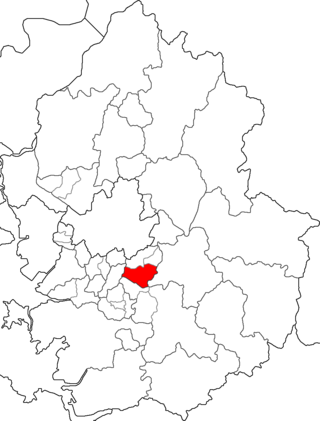
Bundang-gu (Korean: 분당구) is the largest and most populous district (gu) of Seongnam, a major city in the Seoul Capital Area, South Korea. Bundang-gu is one of South Korea's wealthiest and highest developed areas, being the nation's first and largest completely artificial city built in the early 1990s. Many high-rise luxury condos moved in the early 2000s, with a second planned city built in the late 2000s called Pangyo in the same district. Apartment prices are the second highest in Gyeonggi-do after Gwacheon and 7th highest nationwide, higher than many central Seoul districts such as Mapo-gu or Jongno-gu. Apartments around Pangyo station and the high-rise luxury condos around Jeongja station and Sunae station rival prices in the most expensive areas in the country. Unlike older cities such as Seoul, Bundang has no telephone poles overground, resulting in a clean cityscape with well-designed streets.
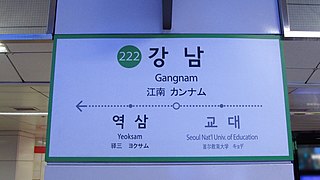
Gangnam is a station on Line 2 of the Seoul Metropolitan Subway. The station is located within the Greater Gangnam Area between the Gangnam and Seocho Districts of Seoul, South Korea. The station is the busiest station on the Seoul Metropolitan Subway, serving over 70,000 daily passengers on average.
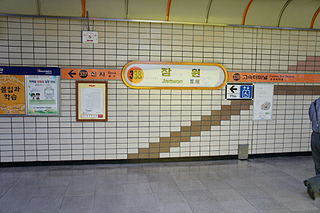
Jamwon Station is a station on the Seoul Subway Line 3. It is located in Jamwon-dong, Seocho-gu, Seoul.

Sinsa station is a station on the Seoul Subway Line 3 and the Shinbundang Line. It is located in Sinsa-dong, Gangnam-gu and Jamwon-dong, Seocho-gu, Seoul. It will serve as the northern terminus of the Wirye–Sinsa Line when it is opened in 2025.
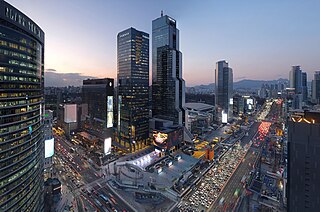
Gangnam District is one of the 25 districts of Seoul, South Korea. The term Gangnam translates to "South of the [Han] River". Gangnam District is the third largest district in Seoul, with an area of 39.5 km2 (15.3 sq mi). As of the 2017 census, Gangnam District had a population of 561,052. There is a high concentration of wealth in the district, with prices for an apartment as of 2020 nearly double those in the rest of Seoul. Gangnam District is part of Gangnam School District Eight, along with the Seocho District. This district shares half of Gangnam-daero Gangnam Station area with Seocho District, which is one of the most crowded places in South Korea.

Seocho District is one of the 25 local government districts which make up the city of Seoul, South Korea. Seocho is a part of the Gangnam region, along with the Gangnam district of Seoul. Seocho District ranks as one of the richest neighborhoods in South Korea and among the most expensive areas in Seoul with an average sales price of 47.75 million South Korean won per 3.3 square meters. Many of the wealthiest residents are concentrated in the three Gangnam districts including Seocho, known as Gangnam School District Eight.
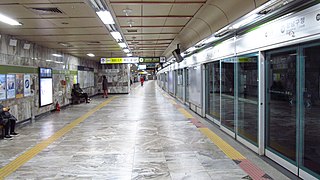
Gangnam-gu Office Station (Korean: 강남구청역) is a station on Seoul Subway Line 7 and the Suin–Bundang Line in the Gangnam district of Seoul.

Express Bus Terminal Station is a station on the Seoul Subway Line 3, Line 7, and Line 9. The stations are located in the Greater Gangnam Area, Banpo-dong, Seocho District, Seoul, Korea.

Seocho-dong is a dong, or neighborhood of the greater Gangnam area Seocho-gu district of the South Korean city of Seoul. Seocho-dong is divided into 4 different dong which are Seocho 1-dong, 2-dong, 3-dong and 4-dong. The main street is Teheranno. There is Gangnam Station in Seocho-dong, which is one of the biggest stations in Korea.

Dogok-dong is an affluent ward of Gangnam-gu in Seoul, South Korea. It is home to high-end residential homes including the Samsung Tower Palace, a luxury residential complex which contains the eleventh-tallest building in South Korea.

Banpo-dong is a dong, neighborhood of Seocho-gu, the greater Gangnam area in Seoul, South Korea. Banpo-dong is divided into five different dong which are Banpobon-dong, Banpo 1-dong, 2-dong, 3-dong and 4-dong.

Yangjae-dong is a dong, neighbourhood of the greater Gangnam area Seocho District in Seoul, South Korea. Yangjae-dong is divided into 2 different dong which are Yangjae 1-dong and 2-dong.
Umyeon-dong is a dong, neighbourhood of Seocho-gu in Seoul, South Korea is part of Gangnam District and a well-known, private neighborhood for the wealthy in southern Seoul. It is a legal dong (법정동) administered under its administrative dong (행정동), Yangjae 1-dong. The first syllable of the name is derived from Umyeonsan, or Mt. Umyeon due to the geographical feature of the area has the mountain.
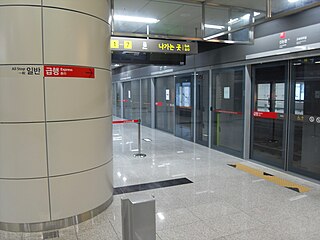
Sinnonhyeon Station is a railway station on Line 9 and the Shinbundang Line of the Seoul Metropolitan Subway, located by the Kyobo Tower sageori in Seocho District and Nonhyeon-dong, Gangnam District, Seoul. It was the southern terminus of Line 9 from 2009 to March 2015, when the line was extended to Sports Complex station. Gangnam Station and Nonhyeon Station are near here. It became a transfer station to the Shinbundang Line on May 28, 2022.

Suji-gu (Korean: 수지구), or Suji, is one of the three city districts in Yongin City, South Korea which is approximately 29 km south of Seoul. Suji became a city district on October 31, 2005, about nine years after Yongin officially became a city. When Yongin City was established in 1996, both urban and rural areas were covered to become a part of the city; thus to this day, Yongin's urbanization is varied throughout different regions of the city. Suji is one of the most urbanized areas of Yongin, as it borders Seongnam City's Bundang District and Suwon City, two more well developed areas. Home to the newly built Shinsegae Department Store and Dankook University in one of its towns, Jukjeon, Suji is rapidly developing as Yongin City becomes more and more urbanized. In recent years, the district has attracted upper-class Koreans, with the completion of the Samsung East Palace in 2010.

Yangjae Citizen's Forest (Maeheon) Station is a subway station in Seoul, South Korea, on Seoul Metropolitan Subway's Shinbundang Line. It opened on October 28, 2011. The subway station appears in episode 1 of the Netflix TV show Squid Game where the main character Gi-hun, is recruited into the death games.

Yangjae Citizen's Forest (Korean: 양재시민의숲) is a park in Seocho District, Seoul, South Korea. The park's official name is now Maeheon Citizen's Forest, which it adopted in October 2022.
Seoul Yangjae High School is a public high school located in Gangnam School District Eight, Seocho-dong, Seocho-gu, Seoul, Korea. This school is directly managed by Gangnam Education Office of the Government of South Korea. The Korean meaning of the school name means qualified student (良才·Yangjae). YHS is K-wave star Lee Jong-suk's alma mater and this is school chosen by many aspiring Korean top-tier students or entertainers living in the Gangnam area. The number of students per grade at Yangjae High School is about 300, around 20 percent of YHS students enter to Seoul National University, Korea University, and Yonsei University (SKY) annually. YHS campus is connected to the National Diplomatic Academy of Korea (국립외교원) and Seocho District Government Office (서초구청). Yangjae Station of Gangnam Seocho District is located right next to YHS.





















